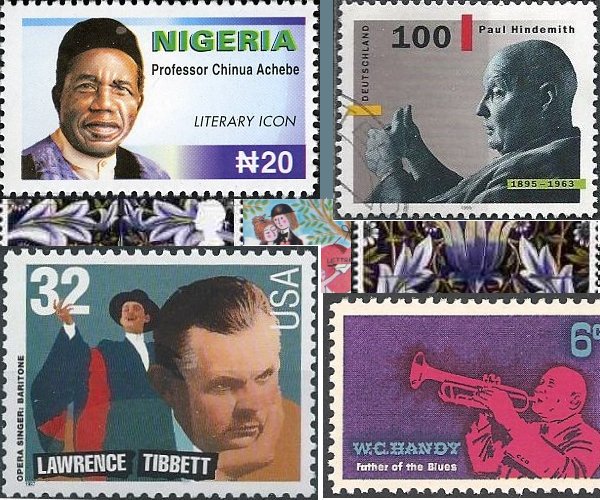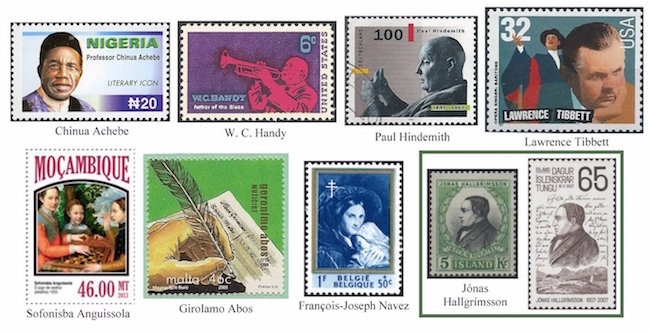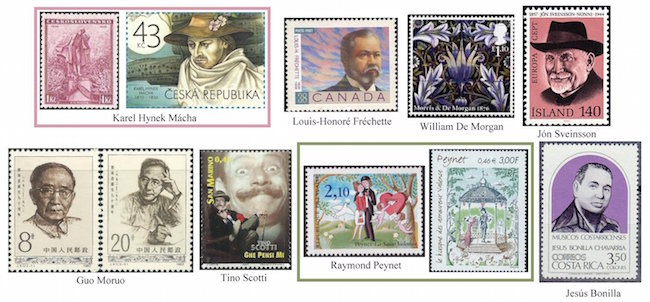The Arts on Stamps of the World — November 16
An Arts Fuse regular feature: the arts on stamps of the world.

By Doug Briscoe
On today’s edition of The Arts on Stamps of the World, we recall Chinua Achebe, W. C. Handy, Paul Hindemith, and Lawrence Tibbett on their birthdays (same day, different years). We have also composers from Malta and Costa Rica, a Belgian painter, two Icelandic writers, poets from Canada and China, an English tile designer, an Italian movie actor, and a French cartoonist! In addition, Sofonisba Anguissola, a fascinating female painter of the Renaissance, died on this date.
One of the foremost literary figures from Africa is Chinua Achebe (16 November 1930 – 21 March 2013), Nigerian Igbo author of Things Fall Apart (1958). Achebe was among the first to matriculate at the new University College (now University of Ibadan) in 1948. He had always been an avid reader, but he decided to become a writer himself after encountering Joyce Cary’s Mister Johnson, which infuriated him with its paternalistic treatment of the Nigerian characters. His first novel, still his most renowned, Things Fall Apart, has by now been translated into 57 languages and sold 20 million copies. Achebe’s controversial 1975 reassessment of Joseph Conrad’s Heart of Darkness brought a new perspective to criticism of that masterpiece. He involved himself in the political landscape of his homeland throughout his life. Nigeria issued a stamp for him in 2006.
W(illiam) C(hristopher) Handy (November 16, 1873 – March 28, 1958) is called the “Father of the Blues”, not because he invented it (he didn’t), but because he consolidated its style and brought it to a much wider public. He was born in a log cabin, which still exists, in Florence, Alabama and was firmly committed to the Christianity of his pastor father, but they didn’t see eye to eye about music. Charles Handy believed that the human voice was the only acceptable musical instrument, and William had to keep his cornet practice a secret. At twenty he played at the Chicago World’s Fair. Three years later he became the leader of a group called Mahara’s Colored Minstrels and toured with them as far as Cuba. Handy had always had a penchant for teaching, and he accepted a faculty position in 1900, but he also continued to learn avidly from listening to other performers, and all of this material found its way into his own creative process. “Memphis Blues”, held by some aficionados as the first blues song, was published in 1912. Over time Handy’s success was such that he could start his own publishing house. A W. C. Handy stamp was issued by the USPS back in 1969.
Paul Hindemith (1895 – 28 December 1963) was significant as a violist and educator as well as a composer. He formed a string quartet while serving as a conscript in the German army in World War I. (There is a photograph of the group in uniform with their instruments.) In 1921 he was closely involved with the first Donaueschingen Festival, where he programmed works by Webern and Schoenberg. He gave the first performance of Walton’s Viola Concerto in 1929. At the invitation of Kemal Atatürk, no less, he made several visits to Ankara in the 30s and led the reorganization of music education in Turkey to much acclaim. Although his advocacy for new music and his own work were publicly condemned by Goebbels, he did have some supporters among the Nazis for those works that embraced tonality and made use of folk elements. He said, “Gee, thanks”, and emigrated to the United States in 1940, where he taught at Yale, some of his students being Lukas Foss, Norman Dello Joio, Harold Shapero, and Yehudi Wyner. Although adopting US citizenship in 1946, he returned to Europe (Zürich) in 1953 and died in Frankfurt a decade later.
A few facts about the great baritone Lawrence Tibbett (1896 – July 15, 1960): his deputy sheriff father was killed in a shootout in 1903; he appeared in a few Hollywood musicals in the early 30s, founded the American Guild of Musical Artists with Jascha Heifetz in 1936, and sang at the Met more than 600 times between 1923 and 1950. He took part in the first recordings of selections from Porgy and Bess, observed by Gershwin himself. In his later years he was host of a radio program on opera. Sadly, he was afflicted with alcoholism and died of a head injury from a fall in his apartment.
Italian painter Sofonisba Anguissola was born into a noble but rather impoverished family in Cremona some time around 1532. She died on this date in 1625. Not only was she a highly accomplished artist, but was widely recognized as such in her own lifetime. Vasari mentions her with cordial approval. She had the advantage of a sound and eclectic education, but it was her meeting with Michelangelo that was her introduction to the patronage, ultimately, of the Spanish court. Anguissola became a tutor to Queen Elizabeth of Valois and, subsequent to that, official court painter to the King Philip II. He arranged a “suitable” marriage for her with a Sicilian nobleman, paid her dowry, and permitted the couple to leave Spain and return to Italy. Five years after her husband died in 1579, Anguissola married again, this time to the captain of a ship she had met in 1582 while traveling. Late in life she received a visit from the young Anthony van Dyck, who sketched her and painted her portrait on his return home. She was at that time about 92. Anguissola is represented on the Mozambican stamp by her self-portrait with her sisters called The Chess Game (1555). The Isabella Stewart Gardner Museum houses another of her works, Juana of Austria and a Young Girl (1561-62).
Girolamo Abos, baptized Geronimo and known also as Avos or d’Avossa (1715 – May 1760), studied under Leonardo Leo and Francesco Durante in Naples and later taught Giovanni Paisiello there. In the meantime he was Director of Music at the Italian Theatre in London. He wrote fourteen operas and, after 1758, a good deal of church music, including seven masses. I don’t know whether he was really left-handed.
The Belgian painter François-Joseph Navez (16 November 1787 – Brussels, 12 October 1869), a pupil of Jacques-Louis David, enjoyed considerable success as a portrait painter, though he also painted many canvases on mythological and historic subjects. For nearly thirty years (1835-62) he was director of the Académie Royale des Beaux-Arts in Brussels. The monochrome stamp from Belgium purportedly shows his work Mother Love, but I can’t find another image of it anywhere online, in lieu whereof, I link to his Self-Portrait.

The birthday of Icelandic poet Jónas Hallgrímsson (16 November 1807 – 26 May 1845) has been a national holiday, Day of the Icelandic Language, since 1996. His father drowned when Jónas was eight or nine, and he went to live with his aunt, then at school, where he earned a scholarship. He studied first law, then literature and natural science, at the University of Copenhagen from 1832 and co-founded a patriotic Icelandic magazine in 1835. Back at home he received a grant to conduct studies in the natural history of Iceland. He translated numerous scientific works into Icelandic and began writing his own poetry, introducing Romanticism into the language’s literature. During a visit to Copenhagen he broke his leg in a fall and succumbed to blood poisoning at the age of 37. The final issue of his journal, Fjölnir, which came out in 1847, was dedicated to his memory.
The life of Czech romantic poet Karel Hynek Mácha (16 November 1810 – 6 November 1836) was even briefer. Another similarity with Jónas Hallgrímsson was the study of law at university, where Mácha began writing poetry. His epic poem “Máj” (May) was rejected by publishers and issued by the author at his own expense. Its greatness was recognized only well after his death from pneumonia, which occurred ten days before his 26th birthday. Mácha also wrote a novel, Cikáni (Gypsies, 1835-36), volumes of autobiographical and travel sketches, and an intimate journal, besides other poems. “Máj” was set as a choral work with orchestra, baritone soloist, and narration by Josef Bohuslav Foerster in 1936.
Yet another law student turned writer was Canadian poet and dramatist Louis-Honoré Fréchette (November 16, 1839 – May 31, 1908), but unlike Hallgrímsson and Mácha he actually did practice law. He founded two newspapers, moved to Chicago, where he wrote a volume of poetry called The Voice of an Exile (1866), returned home, and entered politics. After serving four years as an MP in Ottawa, he retired from the political life and devoted himself to writing. Two more of his six books of poetry, all four of his plays, and some short stories date from this period.
William De Morgan (16 November 1839 – 15 January 1917) was a friend of William Morris, for whose company he designed tiles, ceramics, stained glass, and furniture between 1863 and 1872. Thereafter he set up his own pottery works in Chelsea. Much later De Morgan turned to novel writing and made quite a success of it. The first of his four novels, Joseph Vance (1906), was enormously popular both the UK and the US. The British stamp from 2011 attributes this Acanthus tile panel to both De Morgan and Morris.

It’s rare, if not unique, for us to celebrate two Icelanders on the same day, but Jónas Hallgrímsson shares a November 16 birthday with Jón Sveinsson (1857 – 16 October 1944), a writer of children’s literature better known as “Nonni”, a diminutive form of Jón. His father died when he was twelve, and Nonni was sent to France, but the onset of the Franco-Prussian War led the boy to cool his heels out of harm’s way in Denmark until hostilities ceased. Thereupon he studied at Amiens, converted to Catholicism, and eventually joined the Jesuit Order, ordained as a priest in Liverpool in 1890. He returned to Denmark to teach until ill health forced his retirement, and only then, at age 49, did he write his first book, Iceland Flowers (Islandblomster, 1906). The dozen “Nonni” books followed. Stranded in the Netherlands during World War II, he died in a hospital in Cologne, where he was buried and where today there is a statue and fountain in his memory.
Well, our travels today have taken us to Africa, America, Europe, and the island states of Malta and Iceland, and now we’re off to China and poet Guo Moruo, born Guo Kaizhen on either November 10 or 16 in 1892. Something of a firebrand in his youth, he was expelled from school a number of times. Like his elder brothers, he continued his education in Japan in 1914, turning eventually to the study of medicine. But he was more interested in literature and immersed himself in Spinoza, Goethe, Whitman, and Rabindranath Tagore. Around this time he published his first book of poems, The Goddesses (1921), and founded a literary society. He became a Communist in 1927 and joined the Nanchang Uprising. After its defeat he spent another ten years in Japan, returning to China to join the resistance against the Japanese invasion. He became a fixture of the PRC as the first president of both the Chinese Academy of Sciences and the University of Science & Technology of China. But his prominence—and his pandering to Mao’s machine, including writing self-condemnations and sycophantic party-line puff pieces and denouncing former friends—did not spare him when the Cultural Revolution came along in 1966. Two of his sons were alleged to have committed suicide during this period. Guo seems to have regained his stature by the early 1970s. Guo wrote not only poetry, but also fiction, plays, history, and philosophy. His important work was all written before 1949. Guo died on June 12, 1978.
Italian comic actor Tino Scotti (16 November 1905 – 16 October 1984), born in Milan, appeared in theater and variety shows and on radio before turning to cinema. He made 65 pictures between 1940 and 1984.
Parisian-born illustrator Raymond Peynet (November 16, 1908 – January 14, 1999) created in 1942 a pair of cartoon lovers that became enormously popular in France and elsewhere, leading to all kinds of merchandise. There are no fewer than four museums devoted to Peynet, two in France and two in Japan, and there are two French stamps depicting the lovers, one a Valentine’s Day issue from 1985 and the other one released in 2000 in tribute to the recently deceased artist.
And our world tour ends in Costa Rica with composer Jesús Bonilla Chavarría (1911-1999), who started writing music at age ten. He was a band leader and wrote much music for that ensemble, but there are also orchestral works, including the Scenas Guanacastecas, and some forty songs for schools and colleges. It seems his 300 compositions straddle the classical and popular worlds, with a strong regional emphasis. His most beloved song is the bolero “Liberian Moon”, inspired by the moonlit nights of the city of Liberia in northern Costa Rica. He died on his 88th birthday.
A graduate of the University of Massachusetts with a B.A. in English, Doug Briscoe worked in Boston classical music radio, at WCRB, WGBH, and WBUR, for about 25 years, beginning in 1977. He has the curious distinction of having succeeded Robert J. Lurtsema twice, first as host of WGBH’s weekday morning classical music program in 1993, then as host of the weekend program when Robert J.’s health failed in 2000. Doug also wrote liner notes for several of the late Gunther Schuller’s GM Recordings releases as well as program notes for the Boston Classical Orchestra. For the past few years he’s been posting a Facebook “blog” of classical music on stamps of the world, which has now been expanded to encompass all the arts for The Arts Fuse.
